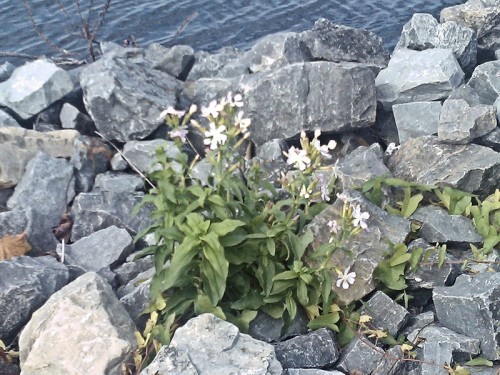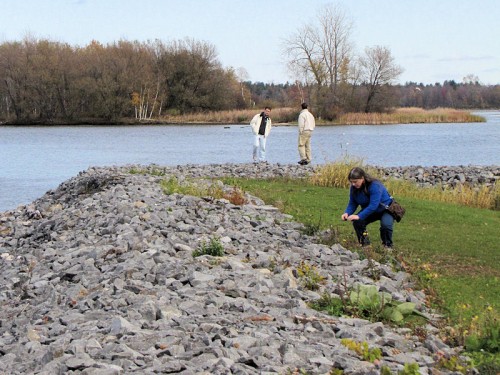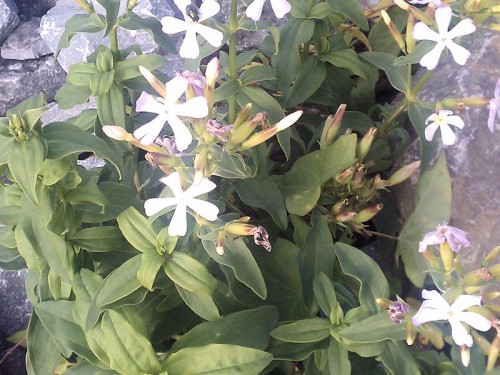This past weekend I had the opportunity to visit Coles Creek State Park in Waddington, NY, which borders the St. Lawrence Seaway. This is almost as far north as you can get in New York State. Parts of St. Lawrence County are USDA Hardiness Zone 3b, but right along the St. Lawrence Seaway it’s “only” Zone 4b. Location is everything, and a large body of water does wonders to moderate the growing conditions. I was walking along the shoreline, marveling at the jewelweed I saw, not because it was a prime specimen–on the contrary, it looked rather beat up–but because it had no frost damage. Jewelweed (Impatiens capensis or I. pallida) collapses in a heap at the first whisper of frost, so I was pretty confident there had been no frost along the shoreline. This place is two hundred miles north of my garden, and I’ve already had a freeze, for pity’s sake.
That almost surreal climatological disjunct must be why I didn’t recognize this plant at first glance:

I came across this plant on the St. Lawrence Seaway shoreline. Photo taken with HTC Droid Incredible
No wonder it looked familiar, I grow it in my garden! But in my garden it doesn’t look so neat and compact. I suppose that could be because it’s trying to grow through and around some large-leaved rhubarb. And in my garden, it’s in one of the moistest spots I have, and here, it’s growing amongst the rocks. Oh, wait, those rocks are right along the shoreline. I bet the roots go right down through them. It’s all starting to make sense now.

According to my 1986 copy of National Audubon Society Field Guide to North American Wildflowers
, soapwort got its name because you can create a lather from the crushed leaves. The Wikipedia article states that museums still use the soap derived from it to clean delicate fabrics. It is a perennial native to Europe, with fragrant flowers that range from white to a light pinkish purple.

Unfortunately, it is also considered a thug by anyone who grows it in a garden. I grew the double form, Saponaria officinalis ‘Rosea Plena’, which is supposed to be less invasive because it doesn’t produce seed. But Jigs and Jo Ann Gardner, writing in Gardens of Use & Delight
report that “after trying unsuccessfully for several years to kill it (Roundup did not touch it), we accepted its presence and learned to chop out extra roots every spring.” Myself, I’m trying to remember if I saw it this year. Between the rhubarb and the lawn mower, it may have died out. I will have to check next spring. At any rate, you’ve been warned.
It was a lesson for me to see how a familiar plant in an unfamiliar location can look so very different. The European settlers brought soapwort with them for its practical uses. The St. Lawrence area began to be settled in the mid to late 1700’s, and I found myself wondering if this plant in front of me was the descendant of one of those brought over by an early settler. It is certainly a plant with a history.

Our intrepid author photo-botanizing with cell phone on the shores of the St. Lawrence River. Photo by Cadence Purdy
Posted for Wildflower Wednesday, created by Gail of Clay and Limestone, to share wildflowers/native plants no matter where you garden in the blogasphere. “It doesn’t matter if we sometimes show the same plants. How they grow and thrive in your garden is what matters most. It’s always the fourth Wednesday of the month!”





Have you ever tried to make a lather with it, Kathy? I think it needs to come live here, but don’t know if we have enough moister anywhere for it. We will not plant it in rhubarb, since we don’t have any of that. The photo of you and cell phone photography is wonderful, a classic! 🙂
I didn’t know it was still being used as soap. It looks beautiful in the middle of the rocks. Love the shot of you taking it’s portrait.
My dear, I love the post, but the photo of you with cell phone is a keeper! If that doesn’t say, “I love plants!” I am not sure what does? Soapwort~I’ve seen it’s thuggish ways in a friend’s garden~She can’t seem to get rid of it! gail
Great info Kathy. I like how you include its different growth habit in the rocks with the moderating influence of the body of water with that which grows in your garden. Thanks.